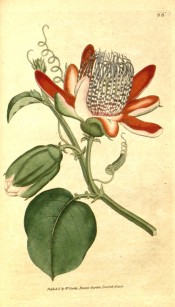Passiflora alata C.Curtis
Frost-tender, robust climber with sparsely-branched, 4-winged stems, broadly ovate, often toothed leaves, to 15cm long, and nodding, fragrant, bowl-shaped, carmine-red flowers in spring and summer, with purple, red and white marked coronas, followed by ovoid yellow fruit, to 15cm long. To 6m or more. [RHSE, Hortus].
Horticultural & Botanical History
‘This splendid plant is a native of the West Indies: it was introduced in 1772, and flowers during the greater part of the summer. It is a fine climber for a stove, which it will not fail to adorn, as well as perfume, with its beautiful and frequent flowers. They last only one day, but are renewed in a continued and very abundant succession.’ [LBC no.246, 1818]. ‘This species of Passion-flower is one of those which have been introduced into the English gardens since the time of Miller; if it does not equal the caerulea in elegance, it excels it in magnificence, in brilliancy of colour, and in fragrance, the blossoms being highly odoriferous: as yet, it is by no means so general in this country, as its extraordinary beauty merits, we have seen it flower this year, both Summer and Autumn, in great perfection in the stove of our very worthy friend James Vere, Esq. Kensington-Gore; at the Physic Garden, Chelsea; and at Mr. Malcolm’s, Kennington; at Chelsea, in particular, it afforded the richest assemblage of foliage and flowers we ever saw. It appears to the greatest advantage, when trained up an upright pole, nearly to the height of the back of the stove, and then suffered to run along horizontally. By some it has been considered as a variety only of the Passiflora quadrangularis, others, with whom we agree in opinion, have no doubt of its being a very distinct species; it differs from the quadrangularis, in having leaves more perfectly heart-shaped, and less veiny; in having four glands on the footstalks of the leaves, instead of six; and in not producing fruit with us, which the quadrangularis has been known frequently to do. The Nurserymen report, that this species was first raised in this country, by a gentleman in Hertfordshire, from West-India seeds.’ [BM t.66/1788].
History at Camden Park
Listed in all published catalogues [T.716/1843].
Notes
Published Feb 18, 2009 - 02:46 PM | Last updated Jul 29, 2010 - 02:08 PM
| Family | Passifloraceae |
|---|---|
| Category | |
| Region of origin | South America and the Caribbean |
| Synonyms | |
| Common Name | Maracuja de refresco, Winged-stem passionflower |
| Name in the Camden Park Record | Passiflora alata |
| Confidence level | high |


